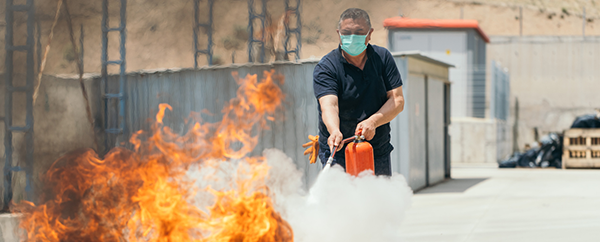
Fire extinguishers are effective tools for preventing the spread of fires if used properly, but rarely do we consider how they function. This quick article outlines their operation and how they extinguish flames. Without understanding how a fire extinguisher works, tribal employees may not be able to effectively use one in the event of an emergency.
Related: Fire prevention tips for small tribal business
Types of fire extinguishers
There are three elements needed to start and perpetuate a fire: heat, oxygen and fuel. While a fire extinguisher cannot remove fuel, they can effectively remove either air, heat or both from this equation by using powders, foam, water or carbon dioxide (CO2). Consider each of these four:
Water
Water is highly effective at extinguishing fires. First, it absorbs large amounts of heat and cooling the fuel below its ignition temperature. Second, it cuts off the fuel’s access to oxygen by smothering it. However, water is not recommended for electrical fires (as it can also conduct electricity), or for fires involving non-water-soluble liquids (which it will simply spread around).
While these factors are excellent for smothering a fire, water extinguishers are limited by the fact that they can only carry the amount of water that can fit inside the canister. Since water cannot be compressed, the canisters empty themselves very quickly and aren’t suitable for larger fires. Water is also extremely heavy, making it difficult to maneuver such an extinguisher effectively.
Powder and Foam
Powder and foam work similarly to water by absorbing some of the heat in the fire, but also by cutting off oxygen supply as they melt onto the fuel and encapsulate it. These agents also release CO2 gas as the foam or powder decomposes in the flame. This is the most common type of fire extinguisher.
Carbon Dioxide
CO2 extinguishers work primarily by cutting off the fuel’s access to oxygen. These extinguishers have large black cones at the end of their hose, which provides an area for the compressed CO2 to expand and cool, forming a frozen, snowlike mist when it is combined with the gas propellant. These cones should be checked regularly for damage or deformation, as any alteration in their exact geometry can cause the extinguisher to malfunction, rendering it useless in a moment of crisis.
How a fire extinguisher works
Function
Mechanically speaking, the operation of a fire extinguisher is simple. A tamper-proof pin-and-ring prevents accidental discharge and can indicate if the extinguisher needs to be checked or serviced. Once the pin-and-ring are removed the handle can be depressed, actuating a valve, it releases the pressurized propellant in the canister either directly out the nozzle (if it’s a CO2 type), or pushes water or dry propellant up and out through the tube. Water can either come out as-is or can mix with a concentrated foam solution as it exits. An advantage of the foam-type extinguisher is that it can be compressed and provide much more foam (and therefore, extinguishing potential) than just the volume of the can itself.
Utility
It is important to remember that the contents of an extinguisher come out very quickly and can be exhausted in a matter of seconds. For this reason, the extinguisher should be pointed carefully and accurately at the base of the fire to maximize its effectiveness when it is deployed.
When deploying a fire extinguisher, employees should remember the PASS method:
P – Pull the pin
A – Aim at base of fire
S – Squeeze the handle or trigger
S – Sweep back and forth
Maintenance
Extinguishers should be checked monthly per OSHA standards for tampering, damage, over/under-charge of pressure, improper placement, obstructions to access and to verify the date of last visual inspection. Extinguishers should also be maintained yearly by a professional. Detailed inspections of the internal mechanics of the extinguisher should be conducted once every 5 to 12 years, depending on type. Remember, a compromised fire extinguisher can fail in a moment of crisis, resulting in damage and injury that might otherwise have been prevented.
Placement
Location of all fire extinguishers should be clear and free of obstructions, at an appropriate height and regularly spaced throughout your facilities. Clear signage should also be installed to indicate their location to any visitors. All tribal employees and volunteers should be aware of all fire extinguisher locations.
Start the year off strong by inspecting all fire extinguishers in your facility. If they have not been inspected recently, consider setting up a regular maintenance schedule. If staff do not understand how a fire extinguisher works, consider sharing this article and hosting a training. For more information on how to effectively place, maintain and use fire extinguishers in your facility, please reach out to your broker or tribal risk manager.
Resources:
Fire extinguishers
How does a fire extinguisher work?
How fire extinguishers work
Categories: Blog employee safety Fire safety
workplace safety
